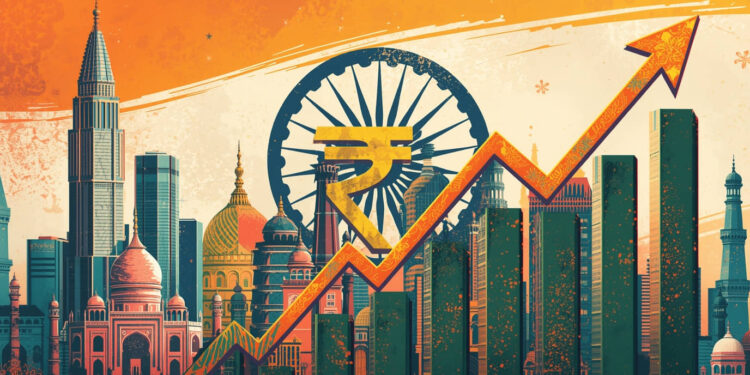Even the IMF estimate had recently stated that India is poised to be the fastest growing major economy in the world, when its GDP projection for 2025-26 was revised upward from 6.4% to 6.6%. This upward revision from the October 2025 World Economic Outlook (WEO) is primarily driven by strong domestic demand, expansion in first-quarter output, and untamed economic strength despite mounting global trade pressures and a heightened tariff regime imposed by the United States.
A Positive Surprise Amid Global Uncertainty
In a world juggling trade tensions, fears of inflation and slowing growth in the major markets, India’s economy continues to stand out as an affluent anomaly. In its October 2025 update, the IMF now forecasts global growth to come in at 3.2% — with advanced economies growing by barely 1.5%, and major emerging market countries averaging around a 4% rate. Against that, India’s estimated 6.6% growth is extraordinary resilience.
The IMF’s downgrade originates from what it terms “a carryover from a strong first quarter” of the fiscal year, when India witnessed an impressive 7.8% increase in GDP during April–June 2025. The increase, the strongest in five quarters, was driven largely by buoyant private consumption and underpinned by strong fiscal and tax reforms — including that September 2025 restructuring of goods and services rates, which harmonized them across sectors and lightened the load on consumer items. Retail demand bounced back as a result, counteracting the hit from reduced exports to the United States and Europe amid trade friction.
Tariff Turmoil and India’s Defiance
India’s financial clout has come despite running into headwinds from the 50 per cent tariffs on its exports to the United States that have been in effect since mid-2025 under President Donald Trump’s new trade order. The IMF noted that these tariffs initially clouded Indias export outlook but contended the overall growth impact was mitigated by resilient domestic demand. That rise in the effective U.S. tariff rate — from 25% to nearly 35.8% by October 2025 — did erode export margins for sectors such as textiles, metals and auto parts.
But strong household consumption, fiscal prudence and sound banking developments enabled India to weather the shock. The results from the IMF indicate India’s domestic markets offering its manufacturing and services sectors more of a buffer than one had anticipated, even as international investors demonstrated they continued to have faith in the country’s ability to manage macroeconomic risks. The IMF also said that the efficacy of tariffs in distorting prices is relatively low for India’s consumer basket as its import dependency ratio in final consumption items, although non-negligible, is low compared to peers.
Strength from Consumption and Reform
India’s robustness is based on its consumption-led model. Private consumption makes up close to 58% of its GDP, a figure well above that for China —38%. The other difference is that unlike export-dependent Asian economies, India’s growth momentum comes from its internal market, its urbanisation and the rising numbers in a burgeoning middle class.
The IMF credits the strong launch to FY2025-26 largely to domestic policy actions. The September 2025 GST reform package was designed to simplify compliance, broaden tax coverage and reduce rates on category essentials and consumer durables in order to incentivize household consumption. This change could contribute an estimated 0.3 percentage points to annual GDP growth, by increasing disposable incomes and a widening breadth of the tax base.
Further, the accommodative monetary policy stance of the RBI in keeping the repo rates unchanged till 2025 set a conducive stage for credit growth. Loan expansion topped 14% y/y but was anchored by a still-moderate inflation of around 4.5%, well within the RBI’s comfort band. This mix of stability in prices and increase in credit spurred investments into infrastructure, housing, industry that made up for the loss due to exports.
Comparison with Global Peers
Only the developed and emerging world would grow faster, in percent terms, through 2025 among major economies. The IMF forecast is for the U.S. to expand about 2.0%, China at around 4.8%, and for the Eurozone a somewhat anemic 1.2%. So, you see, India keeps its crown of fastest growing large economy in the world, and the gap from China — whose structural slowdown persists amid debt overhang and industrial deflation — is widening.
The IMF’s Managing Director Kristalina Georgieva saluted India’s “pragmatic approach to economic growth and reform,” saying it is a “growth leader that has proven resilient to headwinds of global uncertainty. She said India’s regulatory clarity, tech-enabled financial inclusivity and civic multiplier effects from infrastructure spending under the Gati Shakti and PM GatiLink initiatives would be key growth engines.
Downside Revisions for 2026 and Beyond
India’s 2025-26 forecast got a little better, but the IMF lowered its projection for 2026-27 to 6.2%, which is down by 20 basis points from earlier estimates. There are two main factors: the lagged transmission of U.S. trade restrictions and cooling global export demand. Exports of gems, engineering products and pharmaceuticals will cool, although domestic investment will stay robust.
In addition, IMF analysts caution that although India’s short-term resilience is impressive, the ability to maintain above-6% growth in the medium term rests on further structural reforms. These include:
- Expanding financial penetration in rural areas.
- Boosting manufacturing productivity through intelligent automation and digital supply chains.
- Young skilling gaps to maximise potential of the demography.
- Powering up the pathways of transition to reduce fossil-fuel import dependence.
The IMF’s moderation in 2026 reflects a forecast that consumer momentum can normalize after pent-up demand from the post-pandemic recovery wanes.
Emerging Markets and Global Context
The IMF sees emerging markets expanding 4.2% on average in 2025, versus 4.3% in 2024, before it slows to a pace of growth of 4.0% by 2026. India’s performance is thus not only higher than the global average but it is also around 16 per cent of the total incremental world growth after adjustment for IMF Datamapper estimates in absolute terms.
Chinese and other Asian counterparts, however, are set for a combination of slowing exports and weaknesses in domestic demand. Brazil and South Africa, for example, are all at about 2%, while Asean economies tend to average around 5%. This contrast further entrenches India as the leading engine of emerging-market momentum through the late 2020s.
The Role of Reforms and Digital Transformation
India’s reforms record is still drawing accolades from global institutions. The WEO features India’s ambitious investment in its digital public infrastructure (DPI) — notably UPI, Aadhaar integrations and Open Credit Enablement networks — as a game-changer for efficiency and transparency. These platforms have lead to improvements in tax compliance and the emergence of micro-entrepreneurship, as well as greater access to formal credit and increased productivity.
The government’s Production-Linked Incentive (PLI) program also remains a draw for FDI in high-tech manufacturing, electronics and renewable energy projects. By mid-2025 India had won more than $25 billion in manufacturing-related FDI, mostly from companies seeking to diversify beyond China. These inflows, besides adding to India’s export potential, create a deeper eco-system for industry, which adds to the manufacturing GDP potential on a structural basis and not just as an element of cyclical consumption.
Monetary Policy and Inflation Outlook
The IMF report shows India’s exceptional control of inflation in the face of global volatility. Inflation splashed water in 2025 faster than anticipated because of cheaper food and energy, as well as a good monsoon. This result vindicated that the RBI had gone steady. As a result, real rates are still mildly positive, encouraging both saving and investment.
In addition, India’s fiscal prudence — the deficit (around 5.8% of G.D.P.) was kept under control — protected the economy from overheating. The authorities have preferred infrastructure and green energy investment over consumption subsidies, using limited fiscal spending to help sustain productive investment while reducing the scope of fiscal vulnerabilities. “We believe this combination has been a key factor in underlying investor confidence towards India,” international agencies have said about the policy mix.
Challenges Ahead
But even though the outlook is upbeat, India has more medium-term challenges that could keep future expansion at bay. 1. The IMF sees three core threats:
- Export Headwinds: Ongoing elevated U.S. tariffs, alongside limp global trade, could weigh on merchandise exports.
- Mistargeted Employment: A mismatch of job quantity and quality—glowing in services but somber in manufacturing, which is soon quickly automating.
- Energy Import Dependence: While India has made strides in renewable energy, but more than 80% of its crude requirement are still shipped from overseas, leaving it exposed to varying global prices.
Scaling up structural reforms, investment in clean energy and diversification of trading partners are key recommendations from IMF economists for resilience.
Regional Leadership and Global Role
India’s continued growth through global slowdown strengthens its geopolitical position. The IMF and the World Bank now both acknowledge India to be a “stabilizing force for emerging markets,” issuing its economic policies as a model of how open is just balanced by sovereignty. As international investors increasingly look to India as the next manufacturing and digital hub, its capacity to remain macroeconomically stable while elevating innovation will determine whether it thrives in the next growth decade.
During the Washington meetings in October 2025, IMF officials pointed out that India’s impact on global growth related to infrastructure demand, green finance and digital services is higher than those of any other developing country. The country’s strategy, combining reform continuity with fiscal sharpness, has enabled it to ride out the kind of geopolitical upheaval that would have fanned inflationary flare-ups or induced swift capital flight in other markets.
Outlook: Growth with Resilience
IMF’s growth upgrade to 6.6% for FY2025-26 reflects faith in India’s growth story even amidst global uncertainty India’s domestic economy is surprisingly resilient despite trade shocks and tariff steps. It is continued consumption growth, reform implementation and the fiscal prudence that will keep up momentum.
Even if it slows to a relatively modest 6.2% in 2026-27, India is global growth’s last very bright bastion — an economic powerhouse with its head screwed on, one that combines pragmatism and ambition. India’s challenge in the years ahead will be to convert this cyclical resilience into structural strength, by promoting innovation, skilled jobs and sustainable industrialisation.
The IMF’s upward revision is more than just a statistical adjustment — it confirms that India’s reforms are on track. In a world struggling to cope with fragmentation and protectionism, India represents growth against the odds, policy driven-reform, alongside confident economic self-reliance amidst the chaos of an uncertain world.


